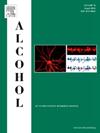在斑马鱼胎儿酒精谱系障碍模型中,单一精油及其二元混合物对乙醇诱发的缺陷具有与叶酸相同的保护作用。
IF 2.9
4区 医学
Q3 PHARMACOLOGY & PHARMACY
引用次数: 0
摘要
本研究评估了丁香(SEO)、白百里香(TEO)、牛至(OEO)和香芹(CEO)精油(EO)及其二元混合物在斑马鱼胎儿酒精谱系障碍模型中的保护作用。此外,叶酸(FA)也被用来进行比较,因为叶酸曾对乙醇(EtOH)引起的缺陷有保护作用。斑马鱼胚胎在受精后 6 或 22 小时内(hpf)同时暴露于乙醇(150 mM)和叶酸(75 μM)或环氧乙烷及其二元混合物(0.5-1 mg/L)。在受精后 8-96 hpf 对不同的发育终点(外胚层测量、24 hpf 的存活率、24 hpf 的胚胎发育进程测量、48-96 hpf 的幼虫发育和 72-96 hpf 的孵化率)进行了评估。暴露于乙醇会减少外胚层发育。只有 FA 和 SEO + TEO 的二元混合物可防止这些缺陷,而 SEO 和 TEO 的单次暴露则可提供部分保护。因此,后续实验选择了这些组别。24 hpf时,EtOH表现出发育延迟,72 hpf时孵化率延迟。FA、SEO、TEO和SEO + TEO对这些缺陷有部分保护作用。这项研究支持FA可部分防止EtOH引起的缺陷的结论。SEO和TEO单次暴露可部分防止EtOH引起的缺陷。然而,SEO + TEO的二元混合物更有效,其功效与FA相似。本文章由计算机程序翻译,如有差异,请以英文原文为准。
Single essential oils and their binary mixtures protect against ethanol-induced defects in a zebrafish fetal alcohol spectrum disorder model at the same level as folic acid
This study evaluated protective effects of clove (SEO), thyme white (TEO), oregano (OEO), and caraway (CEO) essential oils (EOs), and their binary mixtures, in a zebrafish fetal alcohol spectrum disorder model. Furthermore, folic acid (FA) was used for comparison as it had previously shown protection against ethanol (EtOH)-induced defects. The co-exposure of zebrafish embryos to EtOH (150 mM) and FA (75 μM) or EOs and their binary mixtures (0.5–1 mg/L) was carried out during 6 or 22 h postfertilization (hpf). Different developmental endpoints (epiboly measurement, survival rate at 24 hpf, embryonic developmental progression measurement at 24 hpf, larval development at 48–96 hpf, and hatching rate at 72–96 hpf) were evaluated at 8–96 hpf. EtOH exposure reduced epiboly. Only FA and the SEO + TEO binary mixture protected against these defects, and SEO and TEO single exposure showed partial protection. Therefore, these groups were chosen for subsequent experiments. At 24 hpf, EtOH showed developmental delay and hatching rate was delayed at 72 hpf. FA, SEO, TEO, and SEO + TEO partially protected against these defects. This study supports the conclusion that FA partially protects against EtOH-induced defects. SEO and TEO single exposure partially protect against EtOH-induced defects. However, the binary mixture of SEO + TEO was more effective, showing similar efficacy as FA.
求助全文
通过发布文献求助,成功后即可免费获取论文全文。
去求助
来源期刊

Alcohol
医学-毒理学
CiteScore
4.60
自引率
4.30%
发文量
74
审稿时长
15.6 weeks
期刊介绍:
Alcohol is an international, peer-reviewed journal that is devoted to publishing multi-disciplinary biomedical research on all aspects of the actions or effects of alcohol on the nervous system or on other organ systems. Emphasis is given to studies into the causes and consequences of alcohol abuse and alcoholism, and biomedical aspects of diagnosis, etiology, treatment or prevention of alcohol-related health effects.
Intended for both research scientists and practicing clinicians, the journal publishes original research on the neurobiological, neurobehavioral, and pathophysiological processes associated with alcohol drinking, alcohol abuse, alcohol-seeking behavior, tolerance, dependence, withdrawal, protracted abstinence, and relapse. In addition, the journal reports studies on the effects alcohol on brain mechanisms of neuroplasticity over the life span, biological factors associated with adolescent alcohol abuse, pharmacotherapeutic strategies in the treatment of alcoholism, biological and biochemical markers of alcohol abuse and alcoholism, pathological effects of uncontrolled drinking, biomedical and molecular factors in the effects on liver, immune system, and other organ systems, and biomedical aspects of fetal alcohol spectrum disorder including mechanisms of damage, diagnosis and early detection, treatment, and prevention. Articles are published from all levels of biomedical inquiry, including the following: molecular and cellular studies of alcohol''s actions in vitro and in vivo; animal model studies of genetic, pharmacological, behavioral, developmental or pathophysiological aspects of alcohol; human studies of genetic, behavioral, cognitive, neuroimaging, or pathological aspects of alcohol drinking; clinical studies of diagnosis (including dual diagnosis), treatment, prevention, and epidemiology. The journal will publish 9 issues per year; the accepted abbreviation for Alcohol for bibliographic citation is Alcohol.
 求助内容:
求助内容: 应助结果提醒方式:
应助结果提醒方式:


